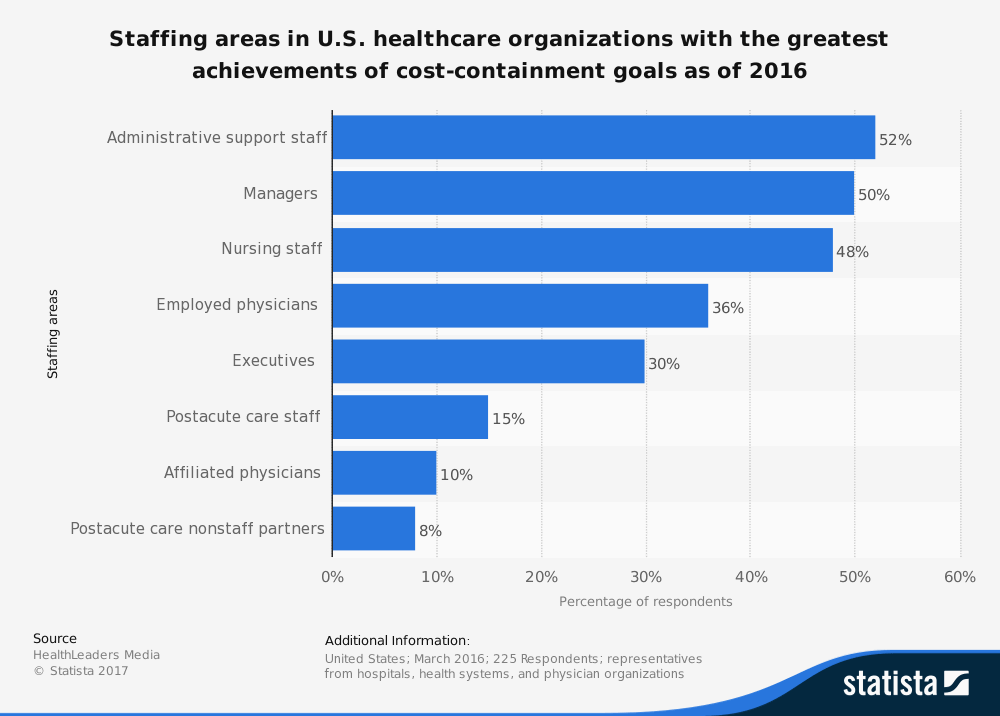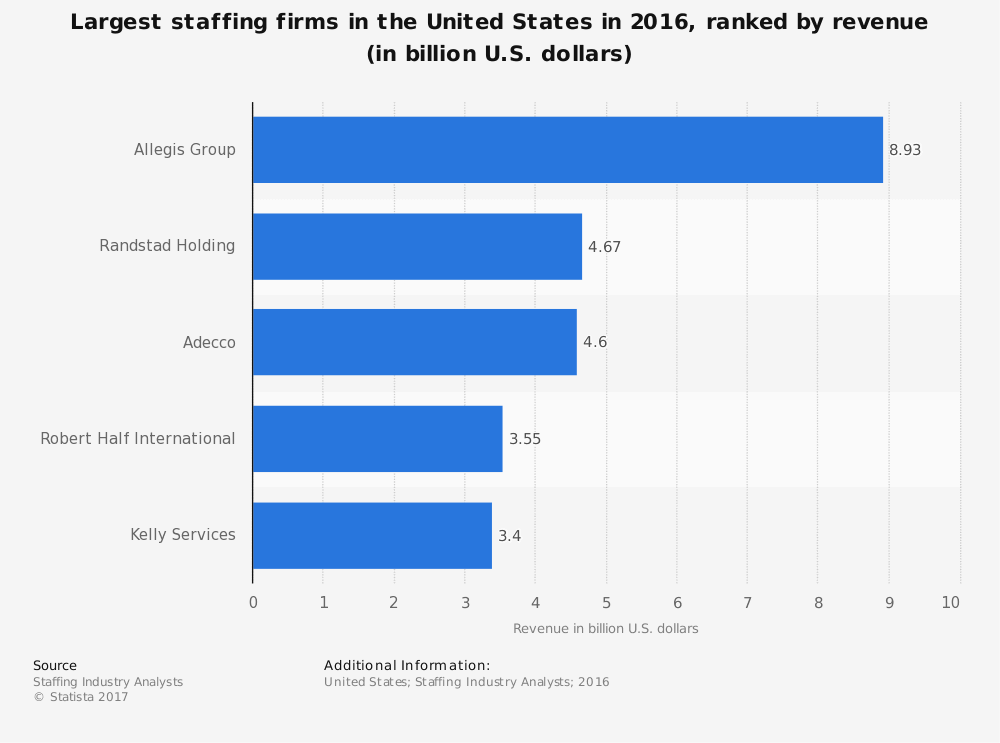Healthcare Staffing Industry- Disruption Needed

Healthcare Staffing Industry
21 Healthcare Staffing Industry Statistics, Trends & Analysis
by Brandon GailleThe healthcare industry, especially in the United States, often faces workforce shortages. This may be fueled because of funding gaps, changes in the local population, or adjustments to national legislation that governs the industry. That means many facilities find themselves needing nurses, physicians, clinicians, and pharmacists that can fill those needs.
That means this industry helps healthcare professionals be able to earn a paycheck, while at the same time generating revenues that can stimulate local and regional economic activities.
Fascinating Healthcare Staffing Industry Statistics
#1. The healthcare staffing industry in the United States is valued at over $11 billion. It has been growing at an average rate of nearly 6% in the past 5-year period. (Harris Williams and Company)
#2. The largest area of growth for the industry is found in the locum tenens placement option. This staffing option places physicians on-staff at facilities for multi-week assignments. The value of this segment is estimated to be $2.7 billion, with 8% growth expected. (Harris Williams and Company)

#3. Travel nursing is another segment that is expected to see better-than-average growth. It offers a current value to the staffing industry of $2.2 billion, with 7% growth expected. (Harris Williams and Company)
#4. The largest segment of the healthcare staffing industry comes through the placement of allied health professionals. Job positions in this category would include physical therapists, radiology technicians, and other support professionals. The value of this segment is estimated to be $3.2 billion, with 6% growth expected. (Harris Williams and Company)
#5. In the United States, the average person who is employed in a locum tenens position earns about $120 per hour and would work about 60 hours per week. Staffing assignments typically last anywhere from 5-24 weeks. (Harris Williams and Company)
#6. The 5 largest travel nursing firms in the United States generated $1.7 billion in revenues in 2015. About 65% of hospitals in the U.S. use travelers to help meet their staffing needs. (Relode)
#7. There are more than 3.1 million registered nurses who are active professionally in the United States right now. About 10% of them find employment opportunities through the healthcare staffing industry. (Relode)
#8. Social media is having a strong influence on how healthcare staffing agencies are finding quality hires within the industry. In the past 5-year period, the quality prospects found through social media have increased by more than 70%. (Relode)
#9. The healthcare staffing industry in the world today is valued at $27.3 billion, which means the U.S. market is responsible for about 45% of the industry’s total revenues. (Grand View Research)
#10. There are about 7.2 million open healthcare positions available in the world today because of staffing shortages. By 2035, the anticipated shortage in this field could reach 12.9 million workers. (World Health Organization)

#11. In 2002, there were about 26,000 physicians who were employed as locum tenens in the United States. By 2013, the number of physicians employed by the industry in this manner reached 40,000 for the first time. (Grand View Research)
#12. Over the course of any given year, staffing companies in the United States hire about 15 million temporary or contract employees. More than 3 million workers are employed by staffing companies during the average week. (American Staffing Association)
#13. 49% of staffing employees say that working with industry professionals for employment opportunities is a good way to get a permanent job. 76% of employees working with the staffing industry are employed full-time. (American Staffing Association)
#14. 90% of people who work with healthcare staffing agencies say that it made their work experience more enjoyable. (American Staffing Association)
#15. About 1 in 3 workers that are associated with the healthcare staffing industry are offered a permanent job after they complete their temporary assignment. About two-thirds of medical professionals who receive a full-time offer will accept it for permanent employment. (American Staffing Association)
#16. In the overall staffing industry in the United States, however, healthcare staffing is only a small component of the market. Just 9% of staffing employees are associated with the healthcare industry. In comparison, 37% of workers are employed industrially, 28% are employed in administrative positions, and 13% are employed in IT, engineering, or scientific fields. (American Staffing Association)
#17. In 2018, staffing jobs have increased by an average of 1.3% when compared to figures from the year before. (American Staffing Association)
#18. There are currently about 20,000 staffing and recruiting companies that are active in the United States right now. They operate about 39,000 different offices. (American Staffing Association)
#19. More than half (55%) of the nursing workforce in the United States is 50+ years of age. More than 525,000 nurses are expected to retire over the next 5 years. The number of employed registered nurses in the 55+ age demographic increased by 24% in 2017. (Staffing Industry Analysts)
#20. The average healthcare staffing industry organization offers job opportunities to about 16 people each year. With the expected nursing shortages increasing, the demand for more workers is expected to increase by up to 16% through the year 2021. (Staffing Industry Analysts)

#21. About 5,000 firms are currently engaged in healthcare staffing in the United States right now. These firms are responsible for the direct employment of about 144,000 people. In the previous 5-year period, the industry experienced an average annual rate of growth of 4.7%. (IBIS World)
Healthcare Staffing Industry Trends and Forecast
In the United States, as Baby Boomers age out of the workforce and need higher levels of medical care due to their age, employment pressures will have medical facilities looking to the healthcare staffing industry for relief.
Retiring Baby Boomers are expected to more than double the costs of Medicare and Medicaid by 2020. A retired 65-year-old couple can expect to pay an average of $275,000 in out-of-pocket expenses for their future medical care. That figure does not include any long-tern rehabilitation or nursing that may be required. More than 10,000 Baby Boomers are retiring every day.
That means the healthcare staffing industry will likely see high levels of revenue growth as skilled workers become harder to find. It will also increase wages for workers within the industry as staffing shortages will affect the quality of care people receive in the future.
With high levels of demand, shortages in service, and rising healthcare costs, the staffing industry looks to be on the verge of changing how we all think about healthcare.


